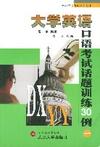大学英语口语考试话题训练30例
出版时间:2002-12 出版社:第1版 (2002年12月1日) 作者:侯艳 页数:501 字数:414000
Tag标签:无
内容概要
本书是为指导高校学生如何准备大学英语口语考试而编写的话题训练教程。全书共分三大部分:第一部分是按大纲样题设计的30例话题训练及参考性答案;第二部分为附录一,内容是涉及话题范围的10篇文章,供学生进行扩展阅读用;第三部分为附录二,内容包括大学英语口语考试、大纲、样题的简要介绍与分析,口语考试的应试策略、考试中常用的基本语言功能和意念表达方式等。
本书是针对口语考试编写的一本内容丰富、有较高实用价值的教程。除了适合高校文、理科学生进行口语训练外,它对参加各种英语口语考试的学生、出国留学人员、自学考试的考生以及有志于提高英语口语的社会人士都有一定的指导意义。
本教程共有话题训练30例,分属于5个大的话题范围,从Topic Area A到Topic Area E。例如:第一个话题范围为Topic Area A:Academic Study,在这个话题范围内共有6例话题训练,细分为Topic 1至Topic 6。每一例话题训练均按口语考试大纲中样题的体例设计,30例话题为30个独立的考试卷的形式(Paper)。每份试卷的右上角标有话题范围及具体话题,例如:第一份试卷上标的Topic A-1表明这属于话题范围A部分的第一例话题。每一例话题均由三部分组成,即:Pant 1,Pant 2和Pant 3。紧接其后的是供考生作为个人陈述用的图画或卡片提示,图画与卡片提示一般按三人组设计,也有供四人组用的提示。哪位考生用哪一幅图或卡片均已标明,考生设计为Candidate 1,Candidate 2,Candidate3(缩写为C1,C2,C3),每一例话题训练后提供参考答案的考生与此处的考生是对应的。
每例话题训练试卷后是Useful Words and Phrases,这些词与词组对本话题的练习很有用,也是参考答案中用到的词和词组。每例话题训练试卷中所有的问题、个人陈述、小组讨论都提供了参考答案,即Reference Answers。
书籍目录
I.Topic Area A:Academic Study Topic 1:Study in the University Reference Answers Topic 2:Study and Relaxation Reference Answers Topic 3:A Qualified Teacher Reference Answers Topic 4:A Qualified University Student Reference Answers Topic 5:Learning English in China Reference Answers Topic 6:Taking the Spoken English Test Reference Answers II.Topic Area B:Campus Life Topic 7:Making Friends Reference Answers Topic 8:Communicating with Friends Reference Answers Topic 9:Part-Time Jobs Reference Answers Topic 10:Hobbies and Interests Reference Answers Topic 11:My Future Job Reference Answers Topic 12:Students' High Expenses Reference Answers Topic 13:Living on or off Campus Reference Answers III.Topic Area C:Education Topic 14:How to Lighten Student's Load Reference Answers Topic 15:Different Ways of Life Reference Answers Topic 16:Sending Children to University Reference Answers Topic 17:University Tuition Reference Answers Topic 18:Studying Abroad Reference Answers Topic 19:Education for All-Round Development Reference Answers IV.Topic Area D:Human Beings and Naure V.Topic Area E:Changes in People's Life 附一:话题文章赏析 Topic-Based Reading Materials 附录二:大学英语口语考试大纲及样题简介
章节摘录
Part 2(10 min utes) Individual presentation:Describe the pictures and compare them. C1:My pictures show that friends communicate with each other by talking and telephoning.Talking is the most common way of commumcation between iriends. When friends are in the same city or in the same place,they usually meet each other on weekends and have a heart—to—heart talk. In the first picture,we see two girls talking to each other hap—pily. In this way they can pily. I guess they are intimate friendS this way they can express themselves directly and there can be a very warm atmo—sphere in face—to—face talk.When they talk to each other,they may use gestures and our partner can understand us well. Friends telephone each other more frequently than before because lt is convenlent and cheap. You can phone your Irlends everywhere in the world.People are busier than before,and most of US choose telephoning when we have something to sayto our friends.In my opnilon,telephoning will save our tlme and talking will our friends directly will save money.Telephoning is an indirect way compared wi th talking. C2:There are two picture on my card.The first picture describesl common way ot COmmunlcatlon:writing letters. I here is a girl friendstudent sitting at the table wrmng a letter her boy lriend away.We see her boy friend in the picture,too.He is reading the letter eagerly.He reads every word carefully,trying to know everything about the girl. The second pmture Shows US that the tw0 students are taking a walk on campus Both of them have some books in their hand. Maybe they are talking about their studies or examinations. There are many trees on the campus and it is very quiet,so it’s a good place to have a face—to—face talk without being interrupt-ed.Face—to—face talk may bring US much happiness.When we are not happy,we need to have a hearty talk with our friends,then we’U be comforted by friends and will get rid of sadness.If our friends are not in the same place,when we miss them,we can phone them and have a short conversation on the phone. Whatever way we may use,communication among friends are qui te necessary. C3:The first picture describes a student sending E—mail.We see a boy si。tti。ng at a computer table,typing a letter. i here is a happy expression on his face.On the computer screen,we see the word:E.mail.W ith the development of computer technolo—gy and the Internet,more and more students communicate with others by E—mails.The greatest advantage of sending E—mail is that you’II save your time.Your friend will get your E—mail several seconds after you send it. The second picture shows that a student is writing a letter to a friend.He has a picture in his mind that his friend is reading his letter.We see a girl in the picture,holding the letter in her hand,reading attentively.W riting letter is a traditional way. Nowadays people seldom write letters but in some undeveloped areas,where there are no computers,people may still communi—cate with others by writing letters. I think writing letters is more emotional than sending E—mail. Discussion:Discuss the topic further and see if you agree on the most popular ways of communication used by college students. C3:I think the most popular way of communication among the col—lege students is telephoning.There are two advantages to it. Plrst,you can hear your triend.svoice and SO it is.more or less,a direct way.Second,you can say whatever you want to say,just like having a face—to—face talk.You can also be emo—tional or show your own feelings. The only disadvantage is that you seem to be very close but can’t see and touch each other. C2:Yes,telephoning is a common way but I think sending E—mail is most common among students.Almost one hundred percent of students can have access to computers and have the experi—ence of surfing the Internet and sending E—mail. It’s so popular because we can get to our lnends lmmediately. C4:But not one hundred percent of students can send E—mail even if they want to. There are limited computers in many universities and some students won’t take the trouble to go to internet cates. ……
媒体关注与评论
前言 全国大学英语四、六级考试委员会在对口语考试进行了历时四年的探讨研究之后,于1999年5月在部分重点院校试行大学英语口语考试CET SET(College English Test—Spok n nglish Test)。2001年5月,口语考试开始在全国范围内推广。 口试试行之时,笔者有幸成为第一批口语考试考官,参加每年两次的考试。在考场上看到很多学生口语流畅、应答自如时,我甚感欣喜;同时,面对考场上那些面红耳赤、吞吞吐吐、自我介绍背得滚瓜烂熟、切人正题时言语苍白、交流时难以应付的考生,我又有一种强烈的欲望想编写能帮助他们进行系统的口语训练的教程,于是,《大学英语口语考试话题训练30例》一、二两本相继出版。 本书是继《大学英语H语考试话题训练30例(一)》后的第二本教程。本教程以教学大纲为指导,以大学英语口语考试大纲为蓝本,从生活、学习等方面筛选出30个学生们熟悉的话题,并按大纲样题编写、设计问题、卡片及图画提示。全书共有问题305道,卡片提示76张,图画提示48幅。 话题内容从学生的学习到休闲娱乐,从电脑到克隆,从网吧到城市犯罪,从买彩票到购私家车,从反腐败到个人成就、幸福,从家庭、婚姻到中、西方传统节日,从生命教育到妇女问题,从网络经济到全球化,从反恐到世界杯,等等,包罗万象,贴近生活,紧跟时代。 本教程的目的是让学生在通过这30个话题训练之后,对口语考试的形式和内容谙熟于心,在考试时能说、会说,做到轻车熟路,游刃有余。 书中所有的问题、卡片与图画提示的个人发言以及小组讨论都有参考答案,其目的在于给学生一定的参照,使之从参照中获得提示与启迪,以开阔思路,使他们能借鉴观点和看法来丰富自己的答案。为检测教程所设计的问题、讨论、图画、卡片的客观性、可答性和可操作性,笔者组织了学生对所有话题的问题、讨论、图画、卡片按要求进行了训练,学生反映很好,教程也得到不断的修正。 话题训练共分6个大的话题范围(Topic Areas),在每个话题范围中从不同的角度设计了话题训练的内容。每一例话题训练的形式均按大纲样题及历次口语考试的形式设计,书中的问题、卡片和图画提示都经过精心的构思和设计。每例话题参考答案前列有一词群,它们是答案中出现过的、并有一定难度的、对谈话有用的词与词组。答案中的人物用C1(Candidatel),艷,C3,即:考生1,考生2,考生3表示。参考答案提供了有参考价值的思路、常识、知识等内容。 本书有较强的针对性和较高的实用价值,使用对象虽为大学英语的四、六级考生,但对其他参加各种口语考试的考生,甚至是研究生、出国口语培训人员以及自学的有志之士都有帮助。 在编写本书的过程中得到王春阁、孟筱康编辑的不断鼓励和热情支持,在此表示衷心感谢。 全书的插图由青年美术教师侯滔绘制,在此一并表示感谢。 由于笔者水平有限,书中的疏漏与不当之处恳请读者、专家、同行指正。
图书封面
图书标签Tags
无
评论、评分、阅读与下载
用户评论 (总计1条)
- 疯狂,速成的字眼太多。让我们忘记了很朴素的学习方法,很多人在口语课堂都做个话题训练,可是却不够系统。而很多口语测试都是以话题为中心的考核。通过本书的学习,就象是个模拟的口语赛场,如果能好好吸收,确实很不错。
